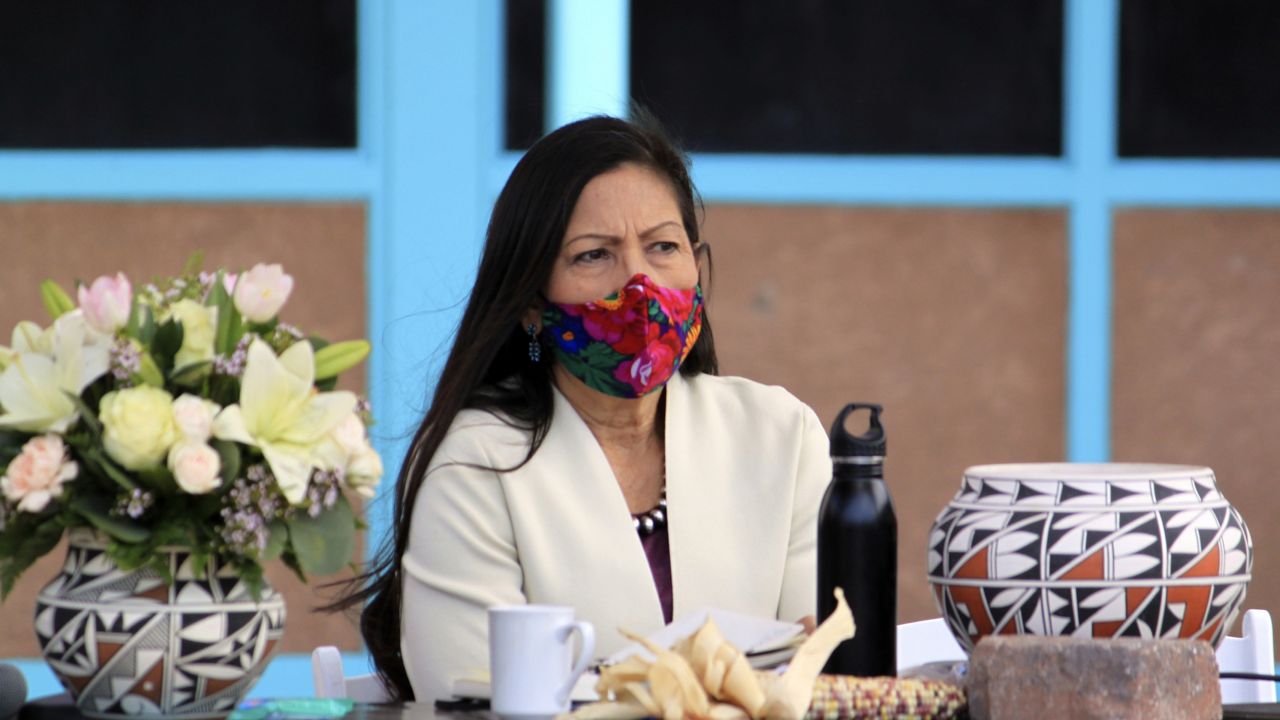Interior secretary Deb Haaland has hit the ground running since her confirmation in mid-March, focusing on wide-ranging issues from improving infrastructure in tribal territories to moving towards a green economy.
This week, Haaland — a member of New Mexico’s Laguna Pueblo and the first Native American Cabinet secretary in U.S. history — traveled to numerous states to meet with tribal leaders and lawmakers, emotional visits that focused on pandemic relief and underscored the significance of her confirmation.
On Tuesday, Haaland traveled to her home state to visit the Indian Pueblo Cultural Center in Albuquerque for a discussion with Gov. Michelle Lujan Grisham, New Mexico Indian Affairs Secretary Lynn Trujillo and members of the state’s congressional delegation.
Tribal leaders told the group their prayers were answered when Haaland was chosen to head the Interior Department, which has broad authority over Native Americans.
She wiped tears from her eyes during her introduction and received a standing ovation.
“Help is on the way,” she told the group — a refrain that Joe Biden’s administration has been echoing from coast to coast during the many visits White House officials and others have been making to tout the federal government’s latest COVID-19 relief package.
Haaland reiterated that every federal agency must recognize its responsibilities to tribes. She also acknowledged the devastating effects of the pandemic on New Mexico’s pueblos and said the Interior Department also lost employees to COVID-19.
More broadly, Haaland pressed for addressing climate change and moving toward a clean energy economy.
Tribal governors told Haaland that protecting Chaco Culture National Historical Park in northwestern New Mexico is a top priority, saying they are frustrated that the U.S. Bureau of Land Management hasn’t done more to stem oil and gas development.
Protections for sacred lands were also a hot topic during Haaland’s trip to Utah on Thursday, where she met with Gov. Spencer Cox, Lt. Gov. Deidre Henderson, Sen. Mitt Romney, and other members of the state’s Congressional delegation to discuss a “path forward” for the Bears Ears and Grand Staircase-Escalante National Monuments.
For decades, a public lands tug-of-war has played out over the two natural monuments. In 2017, former President Donald Trump cut the size of Bears Ears National Monument by 85% and Grand Staircase-Escalante National Monument by nearly half, a total downsize nearing 2 million acres.
In the years since, numerous tribal advocates have asked the government to reverse the Trump-era order — and during his 2020 campaign, Biden signaled he would do just that, while also prioritizing landscape conservation more broadly.
Following her meeting with local leaders on Thursday, Haaland is expected to submit a review with recommendations on whether to reverse Trump’s decision to slice the size of the two national monuments.
The visit underscores her unique position as the first Native American to lead a department that has broad authority over tribal nations, as well as energy development and other uses for the country’s sprawling federal lands.
“She brings something that no other cabinet secretary has brought, which is that her Indigenous communities are coming with her in that room,” said Char Miller, a professor of environmental analysis at Pomona College.
Miller said the outcome of the negotiations will shed light on how the Biden administration plans to respond to other public lands disputes and will likely impact subsequent conversations with other states on natural resources.
Haaland faces competing interests: Tribes across the U.S. have hailed her confirmation as a chance to have their voices heard and their land and rights protected, while Republican leaders labeled her a “radical” who could, along with President Joe Biden, stunt oil and gas development and destroy thousands of jobs.
The Associated Press contributed to this report.



